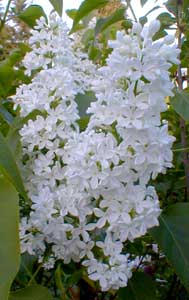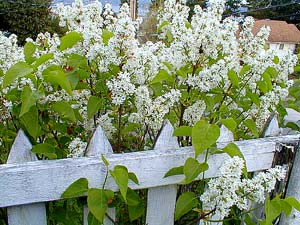 White Common Lilac
White Common Lilac
"The Spring is fresh & fearless
And every leaf is new,
The world is brimmed with moonlight,
The lilac brimmed with dew."
-Sara Teasdale
(1884-1933)
(1884-1933)
White Lilac. Now there's an oxymoron. There are many white lilac cultivars, but there's a fair chance this is the basic Syringa vulgaris 'Alba,' shown in the top photo in April (2004).
It is not growing in our yard, but is growing just the other side of our property line down at the foot of a drop-off cliff where our back-yard neighbor lives (In our own yard we have a young wild-colored variety, shown on the Dark Purple Lilac Page).
The fence which can be seen in the May 2003 photo (shown second on this page) is on top of our garage. Our garage is set into a cliff face, so from our hilltop perch, this is a ground-level deck; but from the neighbor's point of view, he planted lilacs against a cliff.
 The white lilacs at the bottom of that drop-off are about eighteen feet tall, thus forming a sweet-smelling hedge from the perspective of the garage roof-deck. There's also a Light Blue Lilac next to the white, which is a bit shorter than the white, though in 2004 it finally reached the rooftop fence & is now also in easy view.
The white lilacs at the bottom of that drop-off are about eighteen feet tall, thus forming a sweet-smelling hedge from the perspective of the garage roof-deck. There's also a Light Blue Lilac next to the white, which is a bit shorter than the white, though in 2004 it finally reached the rooftop fence & is now also in easy view.What a great thing for the neighbor to have planted, long enough ago they should now be so big as to share their flowery tops with us! It's wonderful to smell them most of April & May.
Lilac is of the Olive family, related to Forsythia & Jasmine. It was originally native to the central Balkins. It may once have bloomed in the woods around Dracula's Castle! It found its way from the peasant gardens of medieval Roumania to the gardens of royal courts as far away as China.
As one of the oldest European garden standards, it was brought to America by the earliest Dutch, English, & French settlers. It is the perfect shrub for temperate & chilly zones, for it is extremely cold-hardy, but needing its buds to experience frost in order to bloom, gardeners in hot climates that experience no particular winter will have to do without it.
The genus name Syringa means "tube" or by inference "hollow twig," & is derived from Syrinx, or pan-pipes, personified as the water nymph Syrinx who rejected the amours of Pan. Lilac does not have hollow twigs, but it does have a very soft pulp through the limbs that is easily hollowed out to make musical instruments or stems for smoking-pipes.